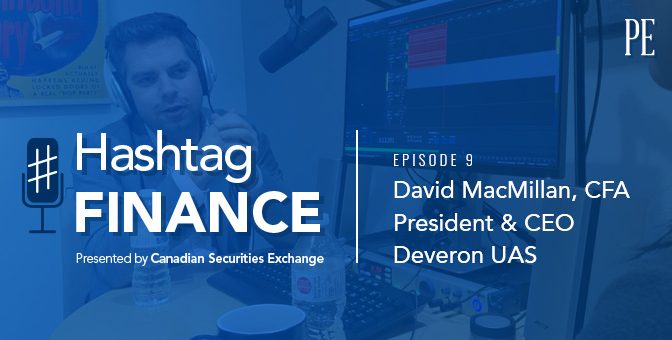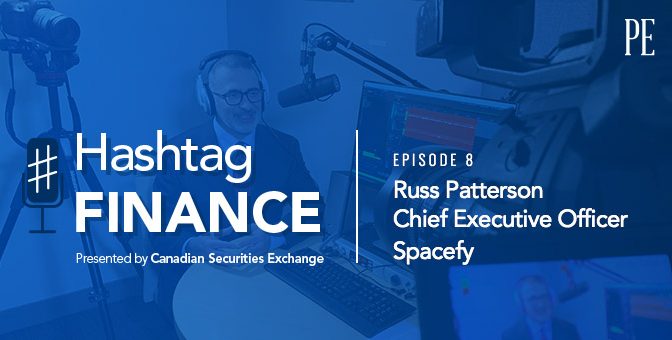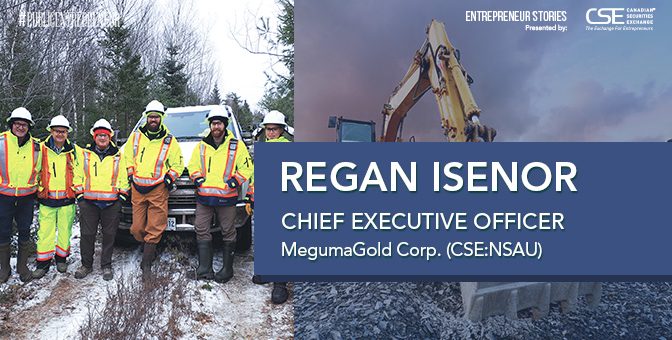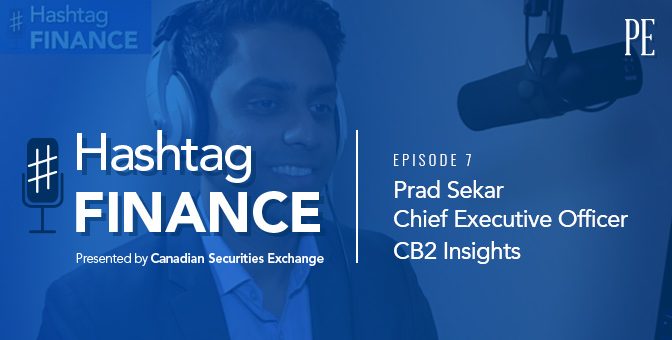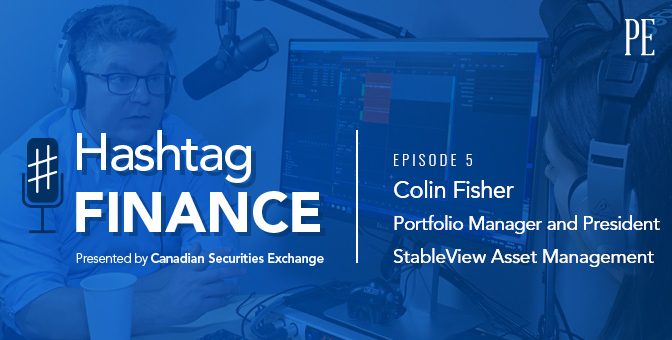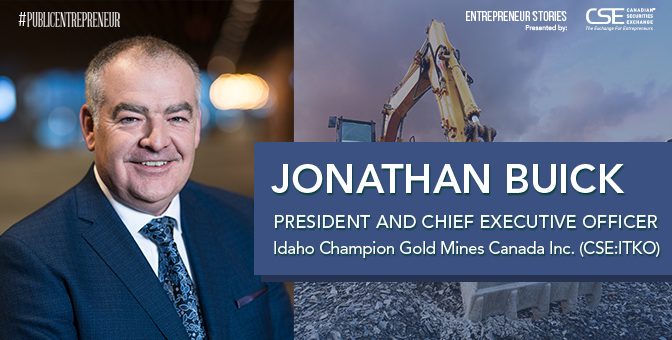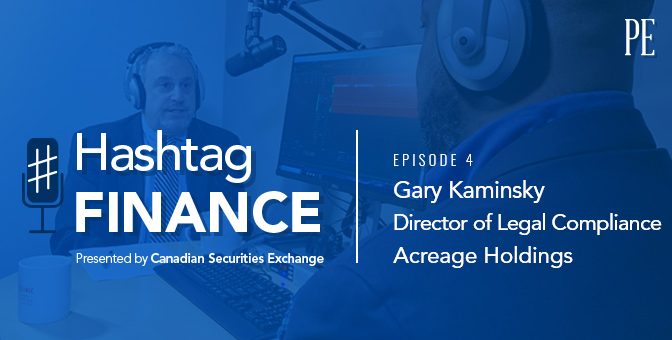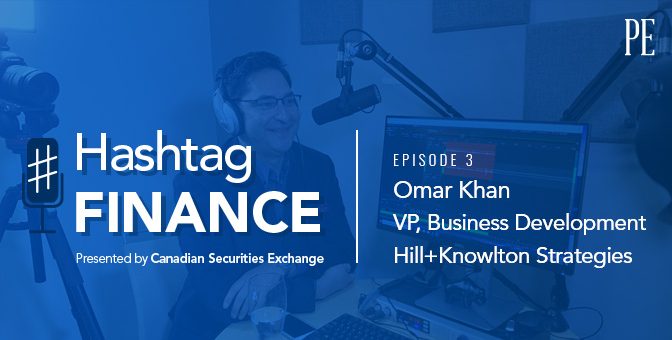David Macmillan, CEO of Deveron UAS (CSE:DVR) recently sat down with Grace Pedota to discuss how drones are changing the manner in which farmers are collecting and using data (5:00), the important similarities shared by farmers and Bay St. bankers, (10:15) and an explanation of why Deveron is laser focused on the agricultural industry (for now) (15:00). Listen until the end to learn how a visit to Silicon Valley was the catalyst to focus on agriculture, what to wear (and not wear) to a farm meeting, and David’s unfortunate run-in with a turkey vulture in the field.
Tag Archives: Public Entrepreneur
Russ Patterson on Using Everyday Spaces to Create One-of-a-Kind Experiences | #HashtagFinance
Spacefy (CSE:SPFY) CEO Russ Patterson recently sat down with Barrington Miller to explain how Spacefy is building the “Airbnb” for creative spaces (3:15), the weirdest booking he’s seen (so far) on their platform (11:00), and ambitions for expansion into global, world-class cities (15:30). Listen until the end to hear about Russ’ favourite creative space and his idea of the ultimate location in Toronto.
Subscribe: iTunes / Spotify / Stitcher / Google Play / RSS
MegumaGold: A fresh take on the gold exploration model for Nova Scotia
The province of Nova Scotia already has a rich gold mining heritage, but new theories and modern exploration technologies are re-awakening interest in the jurisdiction’s huge potential.
It was the site of one of Canada’s first gold camps and production of the metal dates back to around the middle of the nineteenth century.
Between 1862 and 1927 almost a million ounces of the precious metal were extracted from the province.
In those early days, however, the focus was on high-grade, narrow vein deposits. Today, the emphasis has shifted with the discovery of disseminated mineralization with bulk-mineable potential.
The Touquoy deposit
The move started with the discovery of shales at the Touquoy deposit, where a company called Atlantic Gold has now commissioned a highly successful open pit mine.
Now another firm – explorer MegumaGold Corp. (CSE:NSAU), which takes its name from the Meguma Terrane where the original gold rush took place – is getting in on the act. It has acquired 11,205 claims totaling more than 170,000 hectares, many of which are adjacent and along trend from the Touquoy deposit.
Meguma’s chief executive officer, Regan Isenor, explains, “Typically in Nova Scotia, everyone was always after the high-grade nuggety style quartz-hosted gold, which is quite expensive to extract and it’s hard to build models off of that type of mineralization. Atlantic Gold, here in the province, has shown that the disseminated model of low-grade, bulk tonnage is really where the projects that are economically viable are going to be found.”
Without getting too technical, the reason for the geology is this: glaciation in Nova Scotia caused the softer rock on the top to erode, exposing the harder outcrops, which excited those early explorers because the gold was often visible in the quartz veining exposed at surface.
Disseminated mineralization, on the other hand, often cannot be seen and is scattered across large areas at a lower grade but could potentially exist throughout the massive anticline structures within the Meguma Terrane.
Although such mineralization can’t be seen, exploitation of the gold is simple and cheap – simply digging the source rocks out of the ground from an open pit, while cheap processing methods can also be used.
Although the company doesn’t plan to put a deposit into production itself, Meguma wants to emulate the success of its neighbor Atlantic Gold.
Low-cost mine
The latter’s Moose River Consolidated gold mine has the lowest all-in sustaining cost per ounce mine in the world – between US$540 and US$588 – mainly due to the low strip ratio.
Meguma is currently in the middle of a 20,000 meter reverse circulation (RC) drill program focused on 10 highlight targets, whittled down from an original 40, which were identified from a major airborne geophysical and Lidar survey.
Isenor highlights that the company’s targets are predominantly on ground that has “never been tested before,” which is exciting as he believes disseminated gold could be present throughout the province.
He aims to have completed 10,000 meters of drilling by mid-summer, before stopping to have assays returned for evaluation ahead of a larger program, consisting of diamond drilling to focus in on the most exciting targets and RC rigs for more regional exploration.
With enough money in the bank to fully finance the current drill program, specifically around $5.5 million, Meguma hopes to succeed in Nova Scotia where others have had to throw in the towel before.
“People have come in and they’ve had an idea of what a particular model could look like, but they haven’t been funded well enough to actually really test these targets and that’s what we are doing,” says Isenor. “We are really aggressively drilling them. If it’s there we are going to find it.”
MegumaGold was previously called Coronet Metals and was run out of Vancouver by mining executive Theo Van der Linde, with a tailings project in Nevada.
He became aware of the Meguma land package and could see the opportunity. Coronet struck a deal to buy a large land package in the historic gold district and Isenor was brought in as the CEO when the company name changed last June.
The operations base was also moved to Bedford in Nova Scotia and the firm started to raise capital for exploration.
Van der Linde remains as president at the company.
Big goals
Despite its early stage, MegumaGold has big goals as it looks to play a major part in Nova Scotia’s paradigm shift in the understanding and potential of its gold deposits.
Isenor reckons his company stands at the exciting beginning phases of people understanding that this disseminated style of mineralization is really where the future lies and is the economic mining model for Nova Scotia.
“People never really evaluated any of these targets for this disseminated style,” he explains, adding that often such geology was considered by miners to be mere waste rock. New theories indeed.
This story was originally published at www.proactiveinvestors.com on March 8, 2019 and featured in the Public Entrepreneur magazine.
Learn more about MegumaGold Corp at https://megumagold.com/.
Prad Sekar on Leveraging Data to Bring Medical Cannabis to the Masses | #HashtagFinance
CB2 Insights’ CEO Pradyum Sekar recently sat down with Barrington Miller to discuss the importance of medically validated cannabis data (3:45), the challenge of breaking down barriers with physicians (9:45), and the impact of big pharma on medical cannabis (13:30). Listen until the end to hear about Prad’s experience around launching the company, pivoting the business (hint – vertical integration!), and their recent launch on the CSE – Canadian Securities Exchange.
Subscribe: iTunes / Spotify Stitcher / Google Play / SoundCloud / RSS
Sarah Morrison on the Vital (and Not Boring) Role of the Transfer Agent | #HashtagFinance
Sarah Morrison from Capital Transfer Agency sat down with Barrington Miller to explain what a transfer agent actually does (2min), what to do when you find an old share certificate in your attic (7min), and the role blockchain will (or won’t) play in the future of deploying transfer agency services (12:30). Listen until the end to hear how her firm competes with the “big guys” and exciting news about the deployment of CTA’s services across the U.S./Canada border!
Subscribe: iTunes / Spotify Stitcher / Google Play / SoundCloud / RSS
Colin Fisher on the State of the Canadian Tech Scene in 2019 | #HashtagFinance
StableView’s Colin Fisher joins Grace Pedota for a spirited chat about the recent and current trends in Canadian tech finance including an explanation as to why blockchain is still important, despite the initial failures of crypto currency (3:00), why he actually built a crypto mining rig in his office (11:30), and the opportunities emerging in the rapidly growing eSports sector (21:15). Listen until the end to hear his thoughts on going public versus staying private, his solution for tech finance in Canada, and a tease of this year’s upcoming StableView Conference!
Subscribe: iTunes / Spotify / Stitcher / Google Play / RSS
Idaho Champion Gold Mines: Carefully chosen gold project meets with early success in a great state for mining
From his offices in Toronto, Jonathan Buick sees the glitter of opportunity more than 2,000 miles away. On the outskirts of Elk City, Idaho, is Buick’s Xanadu, the Baner project, where he has just struck gold.
“We drilled 19 holes and we hit mineralization on every hole. The further to the north we got, the shallower it was and the better the grade,” says Buick of the 1,705 hectare exploration site.
If history is any guide, Baner’s potential is substantial to say the least. The Elk City area had numerous alluvial gold deposits dredged from the tributaries of the Clear Water River, which runs through it, between the 1850s and the late 1980s. And Crooked Creek, an area just north of the Baner project, yielded about 1.5 million alluvial ounces between 1880 and 1910.
Before moving to acquire Baner in November of 2016 and set up Idaho Champion Gold Mines Canada Inc. (CSE:ITKO) via a reverse takeover, Buick and his colleagues reviewed over 250 gold projects globally. The scope of the search was narrowed to places within an appropriate time zone and a favorable, English language legal jurisdiction. Idaho emerged as the best bet.
“We’re in a good environment. We have great relationships with various agencies and both the US Forest Service and the Bureau of Land Management. They’ve been very supportive. We’ve also made it a real focus to try to hire as many of the local people as we can,” says Buick. “We think it’s important for people to know that we’re here to be good stewards, but also to participate in the economy.”
Baner was purchased for US$500,000 from a local family, who had owned it since the 1890s. Last June, the first exploration of the site in modern times began.
Idaho Champion’s first drilling effort at Baner yielded a discovery zone which is about 500 meters north to south by 200 meters east to west. As much as 5,200 meters of core was drilled in 19 holes as part of this maiden campaign. And the results included an assay from a hole which intersected 5.76 grams of gold per tonne over 12.65 meters.
The company recently purchased six additional claims, which allows it to increase its strike length a further 2 kilometers.
“I believe that we have only scratched the surface on our first exploration program at Baner. We have made a new gold discovery through the drill bit and encountered great initial grades in the highly oxidized zones near the surface,” said Buick. “There was good continuity in the holes and our newly acquired Sally claims will provide us the opportunity to expand the strike length an additional 2 km to the north.”
Particularly exciting is that the drill results show highly oxidized zones near the surface, which improves the grades and makes the gold project “much more economically attractive.”
The results at Baner are being analyzed to plan the exploration program for this year’s field season. Baner remains Idaho Champion’s focus, but just a couple of counties away sits the Toronto company’s second gold project, Champagne, not far from Arco, which it staked in February of 2018.
While the property was in production from 1990 to 1993 as a heap leach gold mine, the previous owners never drilled below 100 meters. Idaho Champion’s geologists think there’s a much bigger system at the 10 square kilometer property that could be characterized by “Midas”-type deposits, consisting of high-grade gold and silver epithermal systems. “We think there’s a much bigger target and a much bigger system underneath,” says Buick. “Our goal in 2019 is to go ahead and do some grassroots exploration.”
Buick is a businessman who likes to have options as a hedge against uncertainty. So, last November, in a bid to diversify, Idaho Champion purchased 822 federal US cobalt mining claims in four blocks – Victory, Fairway, Twin Peaks and Ulysses – (about 6,871 hectares) in the Idaho Cobalt Belt, just outside of Salmon, Idaho, from American Cobalt Corp. for a price of 4 million shares. Buick reports that his investors supported the move.
“When we picked up the cobalt, I went out to each of my investors and said I’m going after some cobalt because I think it’s important to have exposure to the market and also to protect us should we not be successful at Baner,” notes Buick.
Despite a sharp price correction in 2018, growing demand for lithium-ion battery elements are predicted to sustain cobalt prices into the 2020s. And the Idaho Cobalt belt represents a top district for primary cobalt discoveries.
“The standalone cobalt groups are having a challenge finding the capital. But that’s a pause in the market,” says Buick. “Cobalt is going to continue to be a focus and a priority for the end user and capital will come back into the cobalt space. I’m very confident that cobalt will again shine.”
Field work including site surveys, ridge & spur soil sampling, rock sampling and geologic mapping kicked off at Idaho’s four cobalt ventures last November in a bid to gather information for a more robust effort this year.
Buick describes the four cobalt projects as “life jackets” offering protection on the Baner program. Thanks to the recent gold discovery, it looks likely that the cobalt projects will be used to support the work at Baner. “If we had been unsuccessful at making the discovery, we would look to change our focus and apply it to spending on the cobalt,” explains Buick. “We’re now in active conversations with third parties to allow for the monetization of the cobalt to allow us to expand on our gold focus.”
Under review now is whether to spin out the cobalt projects into a new company; to sell them and keep an interest; or bring in a partner. “Right now, we’re reviewing all of those options on the cobalt that will allow us to come back and focus on the gold,” Buick reports.
Having raised more than $400 million throughout his lengthy tenure in finance, Buick, who specializes in securing strategic capital in Korea and Japan as a managing director of Harp Capital and his own investment firm, enjoys a reputation as a money finder.
Before Idaho Champion started trading on the CSE at the end of September, Idaho raised more than US$3 million. It remains pre-revenue, however, and posted a net loss of C$2.36 million in the three months until the end of September, according to its latest regulatory filing statement.
But business is percolating, and Buick is confident that money can be found. “We have shareholders who said they would commit to the next source of funding when that is needed,” he says. He also points out that the company is not only engaged in conversations about its cobalt projects, but it’s also been approached by some larger gold companies about how they can participate in Baner.
Over the next two years, Buick intends to make the mission of Idaho Champion as public as he possibly can. “We’re a newly minted company on a project that hasn’t had modern exploration,” he concludes. “In our first program of exploration we made a discovery, but we’re an unknown story. It’s my job now to get out and get in front of the investor.”
This story was originally published at www.proactiveinvestors.com on March 8, 2019 and featured in the Public Entrepreneur magazine.
Learn more about Idaho Champions Gold Mine at http://www.idahochamp.com/.
Gary Kaminsky on a Holistic Approach to Compliance for Cannabis Companies | #HashtagFinance
Acreage Holding’s Director of Legal Compliance recently sat down with Barrington Miller to discuss the dynamics of working with regulators and lawmakers in the U.S. Cannabis industry (6:00), Acreage’s M&A ambitions (10:30), and the real impact of the Farm Bill (15:15). Listen until the end to hear Gary’s thoughts on the increasing legitimization of the cannabis industry, outlook for the STATES Act, and the integral role of social equity in the cannabis sector.
Subscribe: iTunes / Spotify / Stitcher / Google Play / RSS
Omar Khan on Navigating the Challenges of Marketing Cannabis | #HashtagFinance
Episode 3 — Hill+Knowlton Strategies’ Omar Khan sits down with Barrington Miller to discuss his perspective on the SNC Lavalin Affair (1:45), the challenges of marketing cannabis products (7:15), and his analysis of the Ontario cannabis lottery (11:45). Listen until the end to hear Omar’s thoughts on what the legal cannabis industry will need to do to bring more users over from the black market!
Subscribe: iTunes / Spotify / Stitcher / Google Play / RSS
Richard Carleton on Ushering the CSE into the Cannabis Era and Ukulele! | #HashtagFinance
Episode 2 — In this wide-ranging discussion with Canadian Securities Exchange CEO Richard Carleton, he shows Grace Pedota his chops on the ukulele, discusses the Exchange’s recent trip to Davos, Switzerland (5:15), and shares how the CSE embraced the cannabis industry (12:15). Listen until the end to hear Richard’s origin story as CSE’s CEO and for summer travelling tips!

